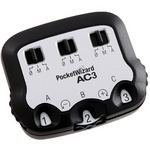Pocketwizards ?
As you all know I’m a big Elinchrom supporter, but this does not mean of course that I’m never testing (or using) other brands.
Normally I’m using the skyport system to trigger my strobes. The skyport system is a very good system that can not only divide the studio strobes in 4 groups but you can also change the output from the skyports on the RX/Quadra and BXri sets. There are also universal skyports to trigger other brands…. so why would there be a need for a different system one might ask….. well there is.
Small flash
I strongly believe in “horses for courses” which for me means that with both cameras and strobes I will use whatever suits the situation, or in other words sometimes I will shoot with small flash and sometimes with natural light or the big strobes. For the small flash you can trigger in a few different configurations.
1. Masterunit
You can use a masterunit to trigger the other strobes, for example the Canon 580EX flash, or the ST-E2.
On both you can set the ratios, HSS works and E-TTL(II) works like a charm.
However the main problem with this method is that there has to be a visible connection between the strobes and the masterunit, don’t even think about placing a strobe somewhere around the corner because that will in most cases not work. Although I have to add that inside this often will work due to the signal/light bouncing off the walls and ceiling and reaching the strobe. But in short there always have to be a visible connection. Also when working in the “bright” sun the range is extremely limited.
2. Skyports (or other triggers)
This works like a charm, just connect the universal skyport to the strobe (for example via a hotshoe or straight to the strobe if that’s supported), and you can use the skyport trigger to fire the strobes around the corner, on top of a mountain or where ever you want, as long as it’s in the reach of the skyports (and that is huge). The main disadvantage however is that you have to work in manual mode…. For me (and maybe also other) that is not a real problem because I almost always measure my strobes in manual mode, but sometimes I wish there would be E-TTL support but hey……. that was not possible…… well it is.
3. Pocketwizard TT series
See the review
Pocketwizard TT1-5
This week I received a package from Mamiya Nederland containing the TT1, TT5, ST4 and AC3.
I will focus later on the last two, but let’s first look at the TT1-TT5.
 TT1
TT1
The TT1 is a very simple/small transmitter but it packs a rather impressive software solution.
Normally with a transmitter you can set the channels and groups (if you’re lucky) and that’s it.
With the TT1 (and TT5) you can do a lot more.
I don’t intend this blogpost as an in depth review (there are some great ones out there) but as a small overview of how I use them, but I can’t resist to list some of the options you can find in the “software” to set the TT1 and TT5, because this is without a doubt some of the most advanced units I have seen. So let’s look at some of the specs of the TT1 which I think are interesting.
Dedicated E-TTL II triggering :
the TT1-TT5 will take over the E-TTLII system and converts it to the radio channel. In practice this means you can even use a 580EX as master unit and set the power output/ratios etc. of the other strobes and send this to the units via the TT1-TT5. Now that’s cool, because in essence this means that although you are working with a radio trigger you can still have FULL E-TTL options including high speed sync…. wow that would be my reason to use this system, but there is more.
Manual power control :
Use an AC3 or 580EXII on top of the TT1 and you open up a lot of extra options in which you can set your power output in 3 groups, and don’t think it stops with small flash NO, read on to the ST4 part of the review.
Optimized HSS :
Pocketwizard uses a “tuned” High Speed Sync system that gives you more power, longer lasting batteries and quicker recycling, and it can be used all the way up to 1/8000.
Hypersync :
With the pocketwizard software (controlTL) you can “fine” tune your response curve from the trigger and in essence make it possible to break the x-sync speed of your camera/strobe combination. And again this is not for small flash but for studio strobes….
Optimized rear curtain sync :
Eliminate the after trails by setting a precise rear curtain sync option.
Pre-flash boost :
Sometimes the normal pre-flash is not enough for E-TTL to work correctly.
With the pre-flash boost you can boost the pre-flash to double the power and get a longer working distance.
Powertracking :
Now this is one cool function.
With powertracking you can set several options, in short it’s possible to set the power of the strobes and when you change aperture or ISO the power output will change accordingly on your strobes (in manual mode), and yes this also works on the Elinchroms and is one real cool feature.
Zone control :
In combination with the AC3 you can use and control 3 zones
Continues fast FPS :
It can happen with systems with high frame rates that the strobes can’t keep up. With the TT1-TT5 system this is no problem any more, shoot at full speed and fill the buffer (as long as the strobes can recycle quick enough).
Built in hot shoe :
You can mount another trigger, strobe or attachment to the hotshoe on top of the TT1-TT5.
Basic trigger mode :
When selecting this mode you can use the TT1 on any camera system that has the same layout, meaning for me that it will also work on my Phase One DF/Leaf combination.
TT5
The TT5 is the larger unit and is usable as transmitter and receiver (switches automatically), the TT5 adds the following options.
Auto-relay mode :
Makes it possible to trigger a remote camera in sync with remote flashes, it can trigger TTL and non TTL lights.
Camera/Flash ports :
Two extra channels where you can connect a camera or strobes to.
Continues remote camera triggering :
On Port 1 you can remotely trigger a camera in a continuous motor drive burst.
Using the system
As mentioned before I did not intend to write an in depth review of the system, so please don’t read it as that. I will explain how I use the system and why I think the system excels the system I’ve used before, but also what I miss and some of the problems I have. Let’s start off by saying that the system looks very nice and the design is simply put very good and the software is simply awesome. But with options that are looking so promising there must be something that doesn’t work as advertised right ? well yes and no.
Small flash
I’ve tested some setups with a 580EXII and the TT1 on a 5DMKII and the TT5 connected to the 580EXII.
This setup rocks.
E-TTLII works just as good as with the ST-E2 and strobe straight on the camera, so only this is already a reason to use this system when you use small flash, it’s simply put awesome to be able to use radio signals and E-TTL, as mentioned before I love to measure my strobes on manual but sometimes I simply want to put it all on E-TTL and just shoot, with the ST-E2 this works fine but with the limitation that the camera and strobe has to “see” each other. Well that “problem” is now solved.
I tried to push the system to 1/8000 and this worked flawless on manual, but do remember that you can’t shoot more power than your strobes gives you of course, so there are limitations in that, but if you want to fight the sun this system works great (manual mode). The nice thing about the Hypersync is that you indeed get some more power out of your strobes, when I compare the HSS setting and the Hypersync setting you can safely say that there is clearly some more output with Hypersync, I don’t want to label the output but I guess between 0.5-1 stop. So that’s a very welcome benefit.
Big flash (ST4)
I also received the ST4 which can be connected to the Elinchrom System (RX, Ranger RX).
In essence it replaces the Skyport RX.
The unit is nice and small and can be set to operate in the “new” method or the basic mode, meaning I can use it on both the Phase One DF/Leaf combi in basic mode and on the Canon 5DMKII on the “new” mode.
The really COOL thing about this unit is the fact that you can use powertracking.
Imagine you have set your lights perfectly on f11 but after a few minutes you realize you would rather use f8.
With skyport system this is not a big deal, you just press the – button 10 times and you’re done, so I was a bit skeptic on this option, however while working with it the “coolness” factor increased, whatever you change on your camera (within the limits of the strobes of course) aperture wise (or ISO) and the strobe will follow, change to 7.1 and the strobe follow, jump to f16 and the strobe follows, this is awesome for working outside with the Ranger and you want to change the look of the ambiant light very quickly without having to use the skyport to change the output, and this works FAST….. leave the shutter speed at 1/125 and just change the aperture on the camera and the strobes follow.
AC3
The AC3 is a small and very light unit you can place on top of the TT1(TT5) and gives you control over 3 groups of strobes (also RX). With the AC3 it’s possible to control the output of for example an RX unit to + 3 and -3 stops (in 1/3rd steps). I have to say that I love this feature better than the skyports for the simple reason that you can access the three rotating knobs within a second, with the Skyport you will have to first set the group and then change the settings and you will have no feedback, with the AC3 you will constantly see the settings in the mini display, and it’s easy to change the output of for example group 2 without having to count and hope that all the steps are also received by the strobe (which in 99% of the cases is no problem by the way with the skyport).
But this is not were it ends…… no it also works with small flash on Manual, E-TTL etc.
Problems
Well not everything is perfect of course.
The reason I asked for the set to test was because I wanted to be able to use higher sync speeds on my strobes outside, on the Canon small flash system it was no problem with my own setup but when using the studio strobes outside I experienced some behaviour I thought/think can be improved. My Phase One DF/Leaf combination should be able to sync up to 1/1600 with a Leaf Shutter lens and it does rather well with the Skyports in speed mode or the Profoto Air system. Both however top out at approximately 1/800 without light loss, when I go up to 1/1600 it looks fine but I loose around 1 stop of light. So that has no use unless I want to freeze action without ambiant light trails. I hoped that with the Hyperspeed I would be able to break the 1/800 and sync up to 1/1600 on the Phase One DF/Leaf combination. At the moment however I’m stuck at 1/320. Whatever I try in the software I seem not be able to break the 1/320 on this combination which is a bit of a let down for me. I do have to add that I’m forced to go to the “basic” mode of course so maybe that has something to do with it, although I don’t think so.
On the 5DMKII I was aiming for slightly less, let’s say 1/800 with the Elinchroms would be fine, but also here I can’t get the system to go much further than 1/320 without having severe banding in the frame from the top down (normal curtain banding is from the b0ttom). I’ve mailed Pocketwizards about this and hope they respond before the review will be online, otherwise I will change the review after warts.
Also triggering with my Sekonic L758DR doesn’t work. I’ve put the ST4 in basic mode but still can’t trigger it. Also for this I hope to get an answer from pocketwizard.
The thing that bothers me somewhat is the fact that when I shoot with the D-Lites I can sync up to 1/1000 without too much light loss (very usable), the D-Lites are a lot slower than the RX and Quadras and when you think about it it’s logical but not what I hoped. The Quadras and Rangers (RX) units are all fast and have a flashduration of well over 1/2200 the D-Lites are all below 1/1000 which means that the light from the D-Lites are longer available for the sensor than the faster units. I’ve tried several settings in the software but I can’t seem to break the limit of 1/320 with the faster strobes. I have to add that outside it will look just fine because ambiant light will also be added to the frame but when you shoot a gray background in the studio the black shadows are clearly seen. I hope I’m doing something wrong and I mailed Pocketwizards about these problems a few days ago, I hoped they would come back to me before the blog post but they didn’t so when they do I will update the review of course. But for now It’s faster on the 5DMKII with breaking the 1/125 limit with normal triggers, but it’s far from what I hoped for, do remember this is with fast studio strobes, when you are using Falcon Eyes, Jinbei, D-Lites or other “slower” strobes you will love this and do I dare to say it’s awesome on those strobes.
Conclusion
If you are investing in a new system to trigger your strobes there are a lot of options, and most are A LOT cheaper than this system. I love the Skyport system for studio or location work with the Elinchrom gear. However with small flash I’m stuck at manual mode. With the TT1-5 you can break this “problem” and have great E-TTL via radio signals, add the ST4 and in the studio you can trigger all your Elinchrom RX strobes on location and in the studio. You can’t change the output like with the skyports in 1/10th steps, you can in 1/3rd stops if you add the AC3 so that’s something I think the Skyport wins hands down and I would therefore prefer the Skyports in the studio personally. However for others setting the strobes correctly once and than use the AC3 to change the balance will work fine. Add to this the awesome powertracking and I’m leaning towards the pocketwizard system again.
However do realize that the system is a lot more expensive than the Skyport system so be prepared to invest, when you do however you will have one of the finest sets out there and total control over E-TTL and a great set for the big flash setups.
For myself I will keep using the TT1 on my camera and the TT5 for my small flash setups.
But I will also keep the ST4 to use the powertracking outside on my Ranger RX because that feature really made my jaw drop, I LOVE IT.
For the Dutch visitors visit www.mamiya.nl for ordering the units from our sponsor.
If you like what we do here, and want to support the blog please buy from our affiliate companies by following the links or the links below.











Thanks for this article Frank, it may have changed my mind. Most tests I have read, some time ago now, stated issues with the system working with 580EXII, the signal was blocked by interference from the small strobes. All the reviews I read were U.S. reviews, and needed the soft shield and hard shield to help with the interference and even then the range was greatly effected, is there a difference with the European versions of either strobe or Pocket Wizard that makes this a non issue? The range problem was my main reason for staying away from this otherwise very useful system, I hated the idea of adding shields and carrying more kit just to use the radio triggers. There were some U.S. workshops that were modifying 580EXII’s to reduce their interfering signal so as to solve this problem. The fact I could use this with big strobes as well is a big plus, I’d rather concentrate on photography not learning a new system for different equipment.nnThanks again.nJonathan
I didn’t find a problem YET, but please remember I’ve been using the system a week now. And today was my first shoot outside on location with it and it worked flawless, I do have to get another TT5 probably but I’m very happy with them for small flash.
Hey Frank, I’ve been lurking on your blog site for a while so this is my first post. If you want to trigger your speedlights via the pocketwizards using the Sekonic L758 you will need to put one of the configuration options (C1 or C2) on the TT5 on “basic trigger mode” by using the Pocketwizard software. I mainly use this option when I’m shooting with my flash on manual and have no assistants on hand to help trigger the lights so that i can measure them.
Weird I did try that. Will try it again.
Volgens mij staat er ergens iets niet goed in je settings frank..ik gebruik zelf de tt1+tt5+ac3 op de canon 5dm2 en ik kan moeiteloos door met m’n shutter tot 1/8000 zonder zwarte banden over mijn frame. Stond de 580 op high speed sync?nnGr. Michel
Hi,nAls je de review leest zie je dat ik met de small flash totaal geen probleem heb. Echter met de studioflitsers en accupacks kom ik niet hoger. In de review staat tevens dat met langzamere studioflitsers de sync tijd hoger is dan dan met de snellere units. nnMet de 580 dus totaal geen probleem, wel even een tip voor je, zet hss op je 580 uit, de hypersync werkt namelijk een stuk beter en geeft je meer flitskracht en snellere recycling. Staat ook in de review 😉
Is it possible to use the AC3 in basic triggering mode to control the output, or do you need to adjust the strobes manually?
In basic triggering I don’t know, it does work in the advanced mode without manual. I guess it will work.
Thanks for this article Frank, it may have changed my mind. Most tests I have read, some time ago now, stated issues with the system working with 580EXII, the signal was blocked by interference from the small strobes. All the reviews I read were U.S. reviews, and needed the soft shield and hard shield to help with the interference and even then the range was greatly effected, is there a difference with the European versions of either strobe or Pocket Wizard that makes this a non issue? The range problem was my main reason for staying away from this otherwise very useful system, I hated the idea of adding shields and carrying more kit just to use the radio triggers. There were some U.S. workshops that were modifying 580EXII’s to reduce their interfering signal so as to solve this problem. The fact I could use this with big strobes as well is a big plus, I’d rather concentrate on photography not learning a new system for different equipment.nnThanks again.nJonathan
Nice writeup Frank. I appreciate your discussion of how they work with the Elinchrom kit. After seeing Scott Kelby use it during his Light it Shoot it Retouch it tour, I decided to purchase those lights. They are on backorder, but after reading this, I can’t wait to get them!nnI bought three of the TT5’s when they came out and suffered from the initial bugs (which were quite severe). After the system was updated a while back, I couldn’t be happier with them. I use them with a small flash setup mostly (580 EXII and a 430 EXII) and the flexibility is fantastic. I was amazed at the range I was able to achieve with this setup, especially compared with the masterunit setup that I was using.nnIf they weren’t so expensive, I would highly recommend them to anybody.
Glad to see someone else is having problems triggering the Sekonic L758 with the Pocketwizard… I would love to hear what the folks from Pocketwizard reply to this. Thanks for the review.nRick from Alabama
At the moment no response yet from Pocketwizard, would have loved to had everything resolved before the review went onlinen
Frank,nCheck out this video from pocketwizard:nnhttp://www.youtube.com/watch?v=zOOq3sX6Ki4
Thought I tried that. Will try it again. I do switch a lot between ettl and manual on location so I hope there is some form of combining it so I don’t have to set the system via the USB every time. Otherwise you would be using an extra tt1 ofcourse to trigger the strobes like I now do with the skyports.
Frank,nI’ve been struggling with the same issue a couple of days ago. Here’s what worked for me:nAs Configuration C2 I’ve disabled both checkboxes in the channel’s tab. In the Misc tab, I’ve enabled the checkbox “Basic Trigger”. Did this for all the TT5s. (Channels should match, of course…) I’m using Nikon, so I don’t know if there’s a difference in the software used for Canon. The config C2 will then work, if the speedlite is set to Manual Mode.
Ok so switch between configuration one and two. That’s doable of course. Will test that next week.
Yes. I’m using C1 for TTL mode and C2 for manual mode just like the regular Pocket Wizard eg Plus II works…
There is an interesting comment below this video:nn”Go back to your set up and press the measuringufeff button of the L-358 to see the red monitor lamp light on the Flex that you set to receive RX CH2. If the red light comes on, the Flex received the trigger signal from the L-358. If the red light blinks, you probably have a Canon flash in the shoe set for ETTL. Needs to be on Manual mode.”nn@Frank: please check your “share on Twitter” link
will check that.nWhat’s wrong with the share on twitter link ? (will check that also)n
I see you’ve deleted all the icons now. The Twitter link should have been written like this (for a week now): twitter.com/share?text=text
Yep, saw the problem, thanks for pointing that out, I’ve now changed the plugin for a temp one. If you have a better suggestion please let me know. nnAgain thanks for pointing that one out.
Frank,nanother video/tutorial page that might help:nnhttp://www.pocketwizard.com/inspirations/tutorials/hypersync_tutorial_video/nnn
Thanks.
Frank: thanks for the great info and the gorgeous photography! Do I need the ST4 to use my pocketwizard TT5 with the ranger quadra? Many thanks!n
ST4 won’t work on quadra, it’s for the rangers and RX.nOn the quadra you will need the TT5.
Any update on this one, Frank? Did PW come back to you?
Yes, and I’m in the process of testing this.
However with the Mamiya I can’t break the 1/320 weird enough, with the Dlites I get over 1/1000 and the meter I still have to test, it’s been a bit hectic.
I wish I had your kind of hectic, Frank! I look forward to the update.
Found the problem, my Sekonic is a US model and the PW are of course EU.
Probably that’s why my meter doesn’t talk to them.
Got a setting from another user which can use his meter with the PW and even with that setting it doesn’t work, so I guess it’s the problem of the US vs EU version of the transmitter.
Ah well, at least you know what the problem is with the Sekonic, which is half the battle.
Did PW ever get back to you about the 1/320 limit on the 5DII? I think I’ve read elsewhere that the speed improvement with the 5D is not that great, so perhaps there’s nothing that can be done about it.
Yes they did, and with the D-lites I get a nice performance of about 1/800-1/1000 it’s the faster strobes it’s struggling with like the RX and BxRi.
Great post ! I too have been using the pocket wizards TT1 and the TT5 along with my 5D MKII and have had great success and minimal problems. The only thing I keep forgetting to do is to shut them off after use. So I keep a supply of extra batteries on hand just for that situation.. lol
Always shut down, but isn’t there a sleep mode 🙂
Hi Frank, I have a question, would it be possible to mix a Canon 580 and Elinchrom using the pocketwizard?
Did not try it “yet” but should be possible if you use the Elinchrom unit from PW.